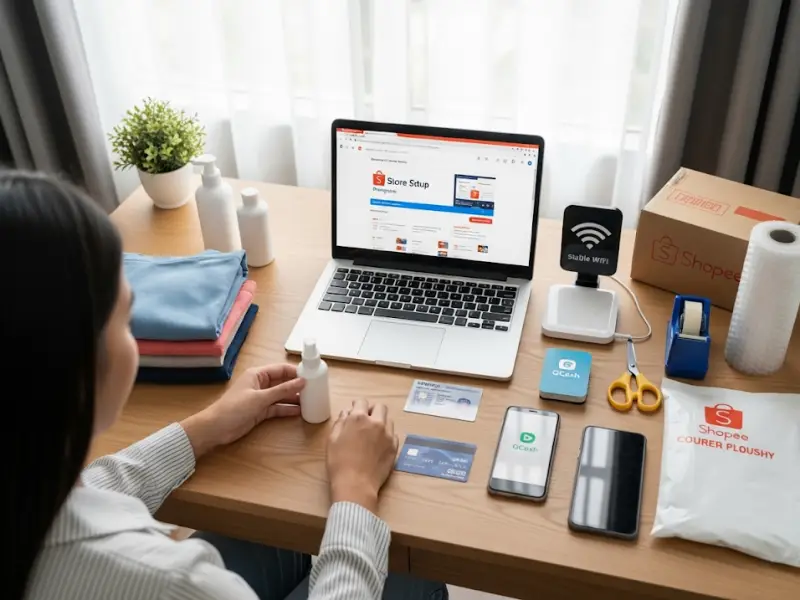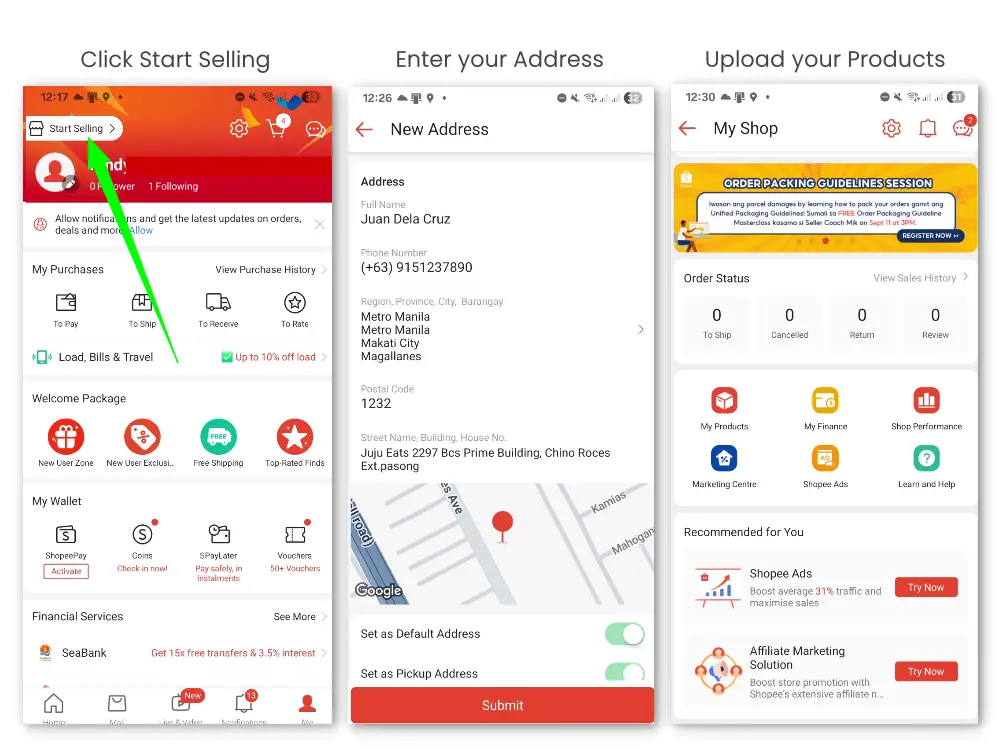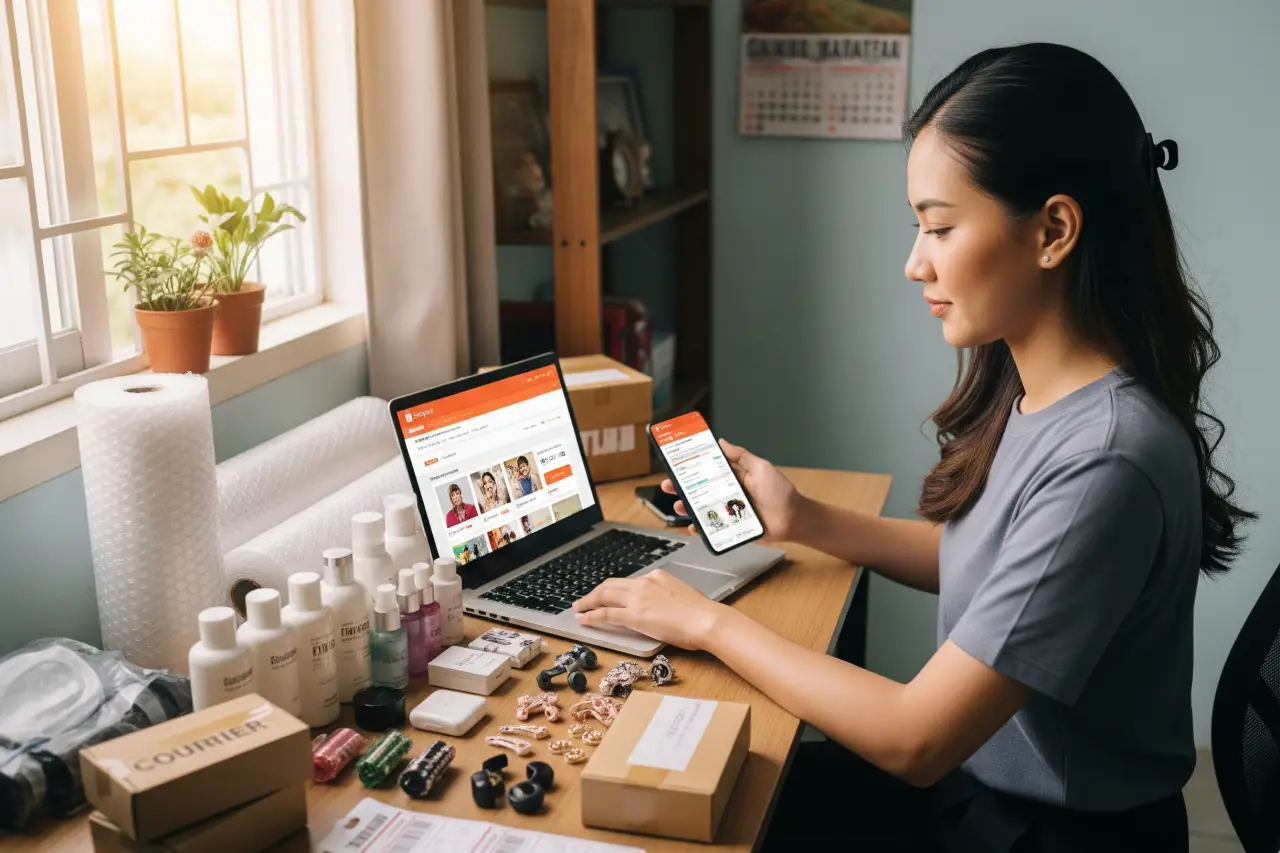Let’s finally answer that question that’s been lingering in your mind: “How do I actually start selling on Shopee?” In 2025, if you’re not online, you’re missing out. Shopee has transformed into the Philippines’ go-to bilihan, a digital Main Street where millions of Filipinos spend their money every single day. The best part? There’s still room for you.
- 📝 Step 1: Prepare the Essentials Before You Register
- 🛒 Step 2: Build Your Shopee Seller Account (Sign-Up & Setup)
- 📸 Step 3: Create Winning Product Listings (Photos, Descriptions, and Pricing)
- 🚚 Step 4: Setting Up Shipping & Handling
- 🎯 Step 5: Marketing Your Store & Attracting Your First Customers
- 📊 Step 6: Managing Orders, Returns, and Customer Service
- ⭐ Step 7: Growing Your Store with Reviews & Repeat Customers
- 💰 Step 8: Understanding Shopee Fees & Profit Margins
- 🚀 Step 9: Scaling Your Shopee Store
- ⚠️ Step 10: Common Mistakes New Sellers Make (and How to Avoid Them)
- ❓ Frequently Asked Questions (FAQs)
- ❤️ Your Shopee Journey Starts Now
Don’t let the idea of “business” intimidate you. You don’t need a massive warehouse or a business degree. This guide is your no-nonsense blueprint, packed with 10 concrete steps to launch your store, find your first customers, and finally turn that brilliant idea into a thriving online negosyo.

📝 Step 1: Prepare the Essentials Before You Register
Before you dive into the sign-up process, make sure you already have the basics ready. Think of this as preparing your paninda before opening a sari-sari store-walang benta kung walang stock. If you want to succeed in selling in Shopee Philippines, preparation is key.
1. Valid ID
Shopee requires at least one government-issued ID (e.g., UMID, Driver’s License, Passport, National ID). This is for verification and payout security.
2. Bank Account or E-Wallet
You’ll need a payout channel to receive your earnings. Most Filipino sellers use a local bank account (BPI, BDO, GCash Bank) or e-wallets like GCash and Maya. Make sure it’s under your name to avoid issues.
3. Smartphone or Laptop with Stable Internet
A reliable device and internet connection are must-haves. You’ll be uploading photos, chatting with buyers, and managing orders daily.
4. Products to Sell
Decide early what you’ll sell. It doesn’t have to be many-start with 3–5 items. You can begin with:
-
Extra stock from your sari-sari store
-
Handmade crafts or food items
-
Pre-loved clothes (ukay finds or personal closet items)
5. Basic Packaging Materials
Even as a beginner, presentation matters. Prepare:
-
Pouches or bubble wrap (Shopee’s integrated couriers may also provide plastic mailers)
-
Tape, scissors, and labels
💡 Pro Tip: Don’t wait until you have 100 products to start. Many successful Pinoy sellers launched with just a handful of items. Focus muna on learning the platform and building your first few sales.

🛒 Step 2: Build Your Shopee Seller Account (Sign-Up & Setup)
Once you’ve prepared the essentials, it’s time to create your Shopee Seller Account. Don’t worry-it’s free and beginner-friendly. Here’s how you do it:
1. Download the Shopee App or Go to the Website
-
Use the Shopee app (iOS/Android) for convenience, but desktop works too.
-
Tap on “Me” > “Start Selling” if you’re on mobile.
2. Register as a Seller
-
You can sign up using your mobile number, email, or Facebook account.
-
Shopee will ask for your valid ID and bank details to set up your payout method.
3. Complete Your Seller Profile
-
Upload a clear profile picture or your store logo.
-
Write a simple but professional store name (avoid random characters or emojis).
-
Add a short bio like: “Affordable local finds, trusted by Pinoy buyers”.
4. Set Up Your Pickup & Shipping
-
Shopee Philippines has partner couriers (J&T, Ninja Van, etc.). You’ll choose which ones to enable.
-
Shopee will auto-generate waybills once you get an order.
5. Upload Your First Products
-
Add at least 3–5 items so your shop looks active.
-
Include:
-
High-quality product photos (clear, well-lit).
-
Honest descriptions (size, weight, material).
-
Tags and keywords so buyers can easily search.
-
💡 Pro Tip: First impressions matter. A shop with a clean logo, decent product photos, and complete info instantly looks more trustworthy to Filipino buyers.

📸 Step 3: Create Winning Product Listings (Photos, Descriptions, and Pricing)
Your product listing is the face of your store. Even if your item is good, kung pangit ang photos or incomplete ang details, buyers will skip it. Here’s how to make yours stand out:
1. Product Photos that Sell
-
Use natural light. Take photos near a window or outside for clear, bright shots.
-
Multiple angles. Front, back, side, and close-up. Show textures or labels.
-
Lifestyle shots. Example: If you’re selling kitchenware, show it in use with food.
-
Clean background. Plain white or wood table backgrounds look professional.
-
Shopee’s free editing tools. Use them to brighten or crop-no need for Photoshop.
📌 Pro tip: Buyers often judge in 3 seconds. Good photos = higher clicks and trust.
2. Writing Descriptions That Convince
-
Start with the product’s benefit. Example: “Perfect for daily ulam, this non-stick pan makes cooking hassle-free.”
-
Include complete details. Size, weight, color options, material.
-
Answer FAQs upfront. Example: “Yes, it fits standard LPG stoves.”
-
Use simple, keyword-friendly language. Avoid flowery words. Instead of “aesthetically pleasing,” just say “simple, clean design.”
📌 Pro tip: Think like a buyer. What would you ask before clicking “Add to Cart”?
3. Pricing Smartly
-
Research competitors. Search for similar items in Shopee and check the average price.
-
Start slightly lower. Especially if you’re new-buyers love bargains.
-
Use bundle deals. Example: ₱120 for one, ₱300 for three. Bulk discounts = more sales.
-
Factor in Shopee fees (5–6%). Always include this in your computation so you don’t lose money.
📌 Pro tip: Price isn’t everything-presentation and customer service can justify slightly higher rates.

🚚 Step 4: Setting Up Shipping & Handling
Before you can make your first sale, you need to make sure your buyers know how their orders will reach them. Good shipping setup = faster deliveries, happier customers, and more repeat business.
1. Choosing Shopee’s Integrated Couriers
Shopee partners with several logistics providers (like J&T Express, Ninja Van, LBC, Shopee Xpress). You don’t need to sign up with them separately-Shopee assigns the courier automatically based on your settings and buyer location.
📌 Tip: Enable multiple couriers. This gives your buyers more options and avoids delivery delays if one courier is overloaded.
2. Setting Up Shipping Fees
-
Who shoulders the shipping? By default, the buyer pays, but you can offer Free Shipping vouchers (subsidized by Shopee) to attract more orders.
-
Weight-based fees. Shopee calculates shipping fees based on weight and size, so make sure your product dimensions are accurate.
-
Free Shipping Promotions. New sellers get access to Shopee’s Free Shipping program-enabling this increases your visibility during sales events.
📌 Example: A ₱300 item + ₱40 shipping feels cheaper than pricing your item at ₱340 with “Free Shipping.” Test which works best for your target market.
3. Packaging Basics for Pinoy Sellers
-
Durability first. Use bubble wrap, carton boxes, or thick pouches, lalo na if selling fragile items.
-
Shopee Packaging Center. You can buy official pouches, stickers, and tape directly in-app for convenience.
-
Label clearly. Shopee automatically generates a waybill/label for each order. Print it or write it neatly if you don’t have a printer yet.
📌 Pro tip: Buyers love sellers who take extra care. A small thank-you note or neat packaging can turn a one-time buyer into a suki.
4. Handling & Processing Time
-
Set a realistic handling time. This is the number of days you need to prepare an order before the courier picks it up. For small sellers, 1–2 days is ideal.
-
Always update order status. Mark items as “Ready to Ship” promptly. Delays in processing can lower your shop rating.
-
Drop-off or Pick-up. Couriers can either pick up from your house/store or you can drop packages at partner branches-pick whichever is easier.
📊 Shipping & Handling Quick Guide
| Option / Factor | Details | Notes / Tips |
|---|---|---|
| Couriers | Shopee Xpress, J&T Express, Ninja Van, LBC (auto-assigned by Shopee) | Enable multiple couriers for flexibility |
| Who Pays Shipping | Usually buyer; seller can join Shopee’s Free Shipping program | Free Shipping boosts visibility |
| Shipping Fees | Calculated by Shopee based on weight & dimensions | Input accurate product info |
| Packaging | Bubble wrap, carton boxes, thick pouches; official Shopee packaging | Add a thank-you note for suki appeal |
| Handling Time | 1–2 days for small sellers; can extend for customized/pre-orders | Faster handling = better shop ratings |
| Pick-up / Drop-off | Couriers can pick up from your address or you drop at partner branches | Choose what’s most convenient |
👉 With your shipping and handling set, your store is now ready to serve customers nationwide. Next, we’ll move into Step 5: Promoting Your Store & Getting Your First Sale.

🎯 Step 5: Marketing Your Store & Attracting Your First Customers
Launching your Shopee store is only half the battle-the real challenge is getting buyers to notice you. The good news? You don’t need a huge budget to market your store effectively. With the right diskarte and consistency, you can attract your first customers and slowly build a base of loyal suki.
🧩 Optimize Your Shopee Storefront
-
Catchy Shop Name & Logo: Keep it simple, easy to remember, and professional. First impressions matter.
-
Product Titles with Keywords: Example: instead of “Bag,” use “Trendy Black Backpack for Students – Durable & Affordable.”
-
High-Quality Photos: Take clear shots with natural light. Add lifestyle photos showing the product in use.
📱 Maximize Social Media
-
Use Facebook Marketplace, TikTok, and Instagram Reels to showcase your products.
-
Short, fun videos (unboxing, how-to-use) can easily go viral and cost nothing to make.
-
Share testimonials from happy customers-Pinoys trust “word of mouth” both online and offline.
🎁 Promotions That Work for Pinoys
-
Free Shipping + Vouchers: Customers in the Philippines love “Sulit Deals.” Offering ₱50 off or ₱100 minimum spend promos can attract first-time buyers.
-
Bundle Deals: Pair related products (e.g., shampoo + conditioner, snacks in packs) to increase sales volume.
-
Flash Sales Participation: Join Shopee’s 9.9, 10.10, or payday sales to boost visibility.
🤝 Build Trust Early On
-
Respond to inquiries quickly. Pinoy buyers appreciate fast replies (“Chat Seller”).
-
Be transparent about shipping times and product details.
-
After a sale, say thank you and encourage reviews. Positive ratings are gold in Shopee’s algorithm.
📊 Mini Table – Easy Marketing Strategies for Beginners
| Strategy | Cost | Effectiveness | Notes |
|---|---|---|---|
| Optimize Titles & Photos | Free | ⭐⭐⭐⭐ | Helps you appear in Shopee search results |
| Social Media Sharing | Free–Low Cost | ⭐⭐⭐⭐ | Great for awareness; TikTok & FB are powerful |
| Free Shipping Voucher | Low (subsidy) | ⭐⭐⭐⭐⭐ | Strong motivator for Pinoy buyers |
| Bundle Deals | Flexible | ⭐⭐⭐ | Works best for consumables & daily use items |
| Joining Shopee Campaigns | Free | ⭐⭐⭐⭐ | Boosts visibility during mega sales |
📊 Step 6: Managing Orders, Returns, and Customer Service
Running a Shopee store doesn’t stop at listing your products-it’s about handling orders smoothly and keeping customers happy. How you manage orders and returns will directly impact your store ratings, repeat buyers, and overall income.
🛒 Processing Orders Efficiently
-
Check Orders Daily: Don’t let orders pile up. Shopee rewards quick processing with higher visibility.
-
Pack Properly: Use bubble wrap, sturdy boxes, or plastic pouches to protect items. Pinoy buyers value neat and secure packaging.
-
Book Shipping Promptly: Arrange courier pickup or drop-off within Shopee’s timeline to avoid penalties.
🔄 Handling Returns & Refunds
-
Know Shopee’s Policy: Returns are usually allowed for defective, wrong, or missing items. Familiarize yourself with Shopee’s Return/Refund Center.
-
Stay Professional: Even if a customer complains unfairly, respond politely. A calm reply builds trust.
-
Proof is Key: Always take photos of packed items before shipping. This protects you if disputes arise.
🤝 Providing Excellent Customer Service
-
Fast Replies: Answer chats within a few hours. Shopee tracks your “Chat Response Rate” and rewards high responsiveness.
-
Clear Communication: If there’s a delay, tell the customer right away. Honesty prevents negative reviews.
-
Go the Extra Mile: A simple thank-you note or freebie (like candy or sticker) can turn one-time buyers into suki.
📊 Mini Table – Order & Customer Service Management
| Task | Best Practice | Why It Matters |
|---|---|---|
| Order Processing | Pack & ship within 24–48 hours | Boosts shop rating & avoids penalties |
| Return Handling | Document with photos & follow policy | Protects against disputes |
| Chat Response | Reply within 1–3 hours | Improves visibility in Shopee search |
| Customer Experience | Add small freebie or thank-you note | Builds suki loyalty |
⭐ Step 7: Growing Your Store with Reviews & Repeat Customers
Once you’ve learned how to process orders and handle returns, the next milestone is turning first-time buyers into suki. In Shopee, your ratings and reviews are as valuable as your products-they build credibility and attract new shoppers.
🌟 How to Get Positive Reviews
-
Deliver on Time: Fast shipping = happy customers.
-
Add Personal Touch: A short thank-you note, small freebie (like candy), or neat packaging goes a long way.
-
Follow Up: Politely ask buyers to leave feedback. Shopee allows you to send a quick reminder in-app.
🔁 Building Repeat Customers (Your “Suki”)
-
Consistent Quality: If they loved their first order, they’ll come back. Avoid downgrading product quality to save costs.
-
Exclusive Discounts: Offer vouchers for returning buyers or bundles that encourage repeat purchases.
-
Engage on Shopee Feed: Post photos, updates, or promos so customers see you’re active.
📊 Why Reviews & Suki Matter
-
Shopee’s algorithm pushes highly-rated shops in search results.
-
Repeat buyers mean less spending on ads, and more stable monthly income.
-
Trust is everything. In the Pinoy mindset, “subok na” (tested and proven) is what convinces people to buy.
💰 Step 8: Understanding Shopee Fees & Profit Margins
Before you celebrate your first sale, it’s important to understand how much you’ll actually take home. Shopee provides a huge platform for sellers, but like any marketplace, it charges certain fees. Knowing these upfront will help you set proper prices and keep your store profitable.
📌 Shopee Fees to Expect
-
Transaction Fee – Shopee deducts around 2% of the item price (exclusive of shipping).
-
Commission Fee (Shopee Mall only) – If you join Shopee Mall, there’s an additional 2–5% fee depending on the category.
-
Payment Fee – Every order has a 2% payment processing fee for GCash, debit/credit card, and ShopeePay.
-
Withholding Tax – For registered businesses, Shopee may withhold 1–2% depending on your BIR setup.
Example: You sell an item for ₱200. After Shopee’s 2% transaction fee (₱4) + 2% payment fee (₱4), your take-home is ₱192.
📊 Profit Margin Basics
Your profit margin is what’s left after deducting product costs, Shopee fees, and other expenses (like packaging, delivery to courier, or marketing spend).
Formula:
Profit Margin = (Selling Price – [Product Cost + Shopee Fees + Other Costs]) ÷ Selling Price × 100
📦 Example Calculation (Small Item)
-
Selling Price: ₱150
-
Product Cost: ₱90
-
Shopee Fees: ₱6 (4%)
-
Other Costs (packaging, tape): ₱4
-
Net Profit: ₱50
-
Profit Margin: 33%
🔑 Key Takeaways
-
Always factor in Shopee fees when setting your prices-don’t price too low just to compete.
-
Higher-priced or bundled items often give better margins.
-
Don’t forget hidden costs like packaging, freebie giveaways, and transport to drop off parcels.
-
In the long run, tracking your real net profit per item is more important than just counting gross sales.
📊 Mini Table – Common Shopee Fees
| Fee Type | Rate / Amount | Applies To |
|---|---|---|
| Transaction Fee | ~2% per item | All orders |
| Commission Fee | 2–5% | Shopee Mall sellers only |
| Payment Processing | 2% | All orders (GCash, card, ShopeePay) |
| Withholding Tax | 1–2% | Registered sellers (depending on BIR setup) |
🚀 Step 9: Scaling Your Shopee Store
Making your first sale is exciting – pero the real goal is building a store that grows month after month. Scaling means moving from a small sideline to a consistent negosyo that brings real income. Here’s how you can do it:
1. Analyze Data to Spot Best-Sellers
Shopee gives sellers access to Shop Insights – use this!
-
Check which products sell fastest.
-
Look at conversion rates (how many people viewed vs. bought).
-
Focus your capital on proven best-sellers instead of spreading it too thin.
2. Expand Your Product Line Strategically
Don’t just add random items. Expand around your niche.
-
If you sell kitchen tools, add trending cookware or eco-friendly utensils.
-
If you sell phone cases, offer chargers, holders, or screen protectors.
-
Think in “bundles” – products that go well together increase cart value.
3. Invest in Shopee Ads (Wisely)
Shopee Ads can push your products higher in search results. Start small (₱50–₱100/day) to test which keywords bring sales.
-
Use Search Ads for visibility.
-
Try Discovery Ads for brand awareness.
-
Monitor ROI weekly – ads should give more sales than they cost.
4. Build Customer Loyalty
Returning buyers are cheaper to keep than finding new ones.
-
Offer discounts to repeat customers.
-
Send a simple thank-you note inside packages (Filipinos appreciate personal touches).
-
Join Shopee’s Follow Prize Campaigns to encourage people to follow your shop.
5. Streamline Your Operations
As orders grow, efficiency matters.
-
Prepare packaging in batches to save time.
-
Keep an updated inventory system (notebook, Excel, or Shopee-integrated POS).
-
Consider hiring part-time help if orders are consistent.
6. Join Major Shopee Campaigns
Shopee’s mega-sales (9.9, 11.11, 12.12) bring massive traffic. Participate by preparing stocks early, collecting vouchers, and setting competitive but profitable prices.
📊 Mini Table – Scaling Tactics
| Scaling Move | Why It Works |
|---|---|
| Focus on best-sellers | Concentrates capital on proven demand |
| Expand product line wisely | Boosts cart value & repeat sales |
| Run Shopee Ads | Increases visibility & discoverability |
| Customer loyalty programs | Builds repeat buyers and word-of-mouth |
| Streamlined operations | Handles more orders without stress |
| Join mega-sales campaigns | Taps into Shopee’s massive traffic |
⚠️ Step 10: Common Mistakes New Sellers Make (and How to Avoid Them)
Getting excited is easy; staying smart is the challenge. The path to a thriving Shopee store is paved with rookie mistakes that can drain your profits and passion. Here are the most common traps and the diskarte moves to outplay them.
1. The Trap: The Race to the Bottom (aka “Presyong Palugi“) The newbie instinct is to be the cheapest seller on the block. But after Shopee’s fees, your packaging costs, and your own effort, pricing too low means you’re basically paying customers to take your products. That’s not a business; it’s a giveaway.
✅ Your Diskarte Move: Compete on value, not just price. Your price should protect your profit. Instead of slashing another ₱10 off, add a small freebie, create product bundles, or offer the best customer service on the platform. Build a brand people trust, not just a shop that’s cheap.
2. The Trap: The “Bahala Na” Product Listing In e-commerce, your photos are the customer’s hands. Blurry, dark pictures and lazy, one-line descriptions (“Good quality, PM for details”) scream “untrustworthy seller” and kill sales before they even begin.
✅ Your Diskarte Move: Treat your product page like a physical storefront. Your photos must be bright, clear, and show the item from every angle. Your description is your salesperson-it must include specs, dimensions, benefits, and how to use the product. Sell the experience, not just the item.
3. The Trap: Forgetting That Bubble Wrap Isn’t Free It’s a classic story: a seller makes a hundred sales but loses money. Why? They forgot to account for the “invisible” costs: bubble wrap, tape, printing waybills, and even your pamasahe to the drop-off center. These small expenses bleed profits dry.
✅ Your Diskarte Move: Create a cost checklist for every single item. Factor in packaging and operational expenses before you set your final price. Treat these costs as part of the product itself, not an afterthought.
4. The Trap: The “All In” or “All Out” Inventory Gamble Going “all in” by buying hundreds of a product you think will sell can trap your capital in dead stock. On the other hand, having too little inventory means you’ll run out of stock during a 9.9 sale, disappointing customers and killing your momentum.
✅ Your Diskarte Move: Be a market-tester, not a gambler. Start with a small, manageable quantity (5-15 pieces). See which products get clicks and sell fast. Once you’ve identified your bestsellers-your future “suki favorites”-you can confidently invest and stock up more.
5. The Trap: The “Seen Zone” School of Customer Service Leaving inquiries on “read,” being slow to respond, or arguing with a customer over a return will destroy your shop’s reputation. A single 1-star review from an angry buyer can scare away dozens of future customers.
✅ Your Diskarte Move: Be obsessed with customer satisfaction. Respond quickly and politely, even to difficult questions. Handle issues professionally. Remember, a happy customer who leaves a 5-star review is your most powerful marketing tool. Your reputation is your real capital.
6. The Trap: The Siren Song of “Magic Boosts” You’ll see them on social media: shady “gurus” promising to triple your sales overnight with fake reviews or mysterious “boosting services.” Following their advice is the fastest way to get your account flagged, penalized, or permanently banned by Shopee.
✅ Your Diskarte Move: Play the long game and use the official tools. Invest a small amount in Shopee’s internal ad platform to learn how it works. Earn your reviews organically by being an excellent seller. There are no shortcuts to building a legitimate, lasting business.
❓ Frequently Asked Questions (FAQs)
-
Do I need a business permit to sell on Shopee?
Not right away. For casual or small-time selling, you can start without permits. But if you want to scale, join Shopee Mall, or issue receipts, you’ll eventually need DTI/SEC and BIR registration. -
How much capital do I need to start selling in Shopee Philippines?
You can start with as little as ₱2,000–₱5,000 if you’re reselling small items. For a more consistent store, ₱10,000–₱20,000 is a good range for initial inventory. -
Can I sell second-hand or pre-loved items?
Yes, Shopee allows it, but avoid prohibited categories (like used cosmetics, medicines, or anything counterfeit). Clothes, books, and gadgets are common second-hand items sold. -
How does Shopee shipping work for new sellers?
Once you set up shipping, Shopee’s partner couriers (J&T, JRS, Shopee Xpress, etc.) handle pickup or drop-off. You don’t need to deal with shipping companies directly. -
Do I need to pay Shopee to open a store?
No. Setting up a Shopee store is free. However, Shopee takes a small commission and transaction fee from each sale (around 8–12%). -
When do I receive my money from sales?
Shopee releases your earnings once the buyer confirms receipt or after the order auto-completes. Funds go to your Shopee Wallet, and you can transfer them to your bank or e-wallet. -
What are the best items to sell for beginners?
Small, affordable, fast-moving products like phone accessories, kitchen tools, beauty items, and trendy gadgets usually perform well. -
Can I sell on Shopee while working full-time?
Yes, many sellers start Shopee as a side hustle. Just make sure you can manage orders and customer service on time to avoid penalties. -
Is ShopeePay required to sell?
Not required, but highly recommended. ShopeePay gives buyers more payment options and often boosts visibility of your store in campaigns. -
How do I avoid scams as a seller?
Never transact outside Shopee’s platform, always ship through Shopee’s courier options, and double-check buyer details before shipping high-value items.
❤️ Your Shopee Journey Starts Now
The journey from ‘Shopee buyer’ to ‘Shopee seller’ can feel like a huge leap. Feeling overwhelmed is part of the process. But remember this: every multi-million peso store you admire started exactly where you are now-with a first product, a first photo, and a healthy dose of hope and diskarte. Their success wasn’t magic; it was built on the discipline of doing the small things right, every single day.
It’s about replying to that one inquiry, packing that one order with care, and making sure your photos tell the best story. This is how trust is built and how a customer becomes a loyal follower.
So, stop waiting for a sign. Consider this your starting gun. That online negosyo you’ve been dreaming of doesn’t begin “someday.” It begins today, with your first listing. Go get it.










